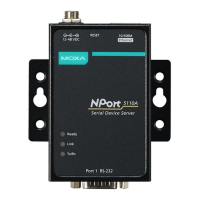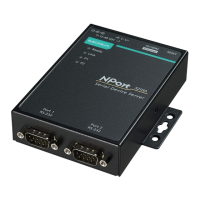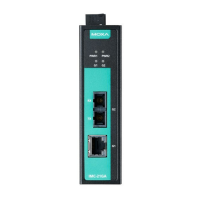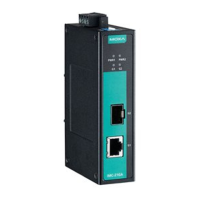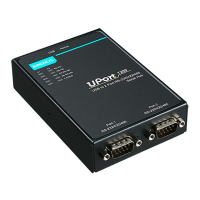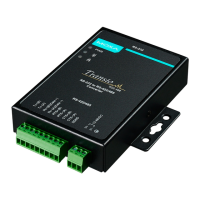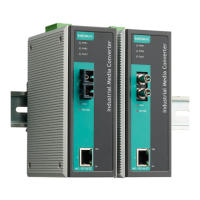
Do you have a question about the Moxa Technologies NPort 5130A and is the answer not in the manual?
| Isolation | 1.5 kV |
|---|---|
| Certification | CE, FCC |
| Serial interface type | RS-422, RS-485 |
| Serial ports quantity | 1 |
| Ethernet LAN data rates | 10, 100 Mbit/s |
| Supported network protocols | ICMP, IP, TCP, UDP, DHCP, BOOTP, Telnet, DNS, HTTP, SMTP, IGMP v1/2 |
| Compatible operating systems | SCO Unix, OpenServer UnixWare v2.1, v7 Unix SVR 4.2 Unix QNX 4.25, QNX 6 Solaris 10 FreeBSD AIX 5.x HP-UX 11i Mac OS v10.3 Linux v2.4.x, v2.6.x |
| Storage temperature (T-T) | -40 - 85 °C |
| Operating temperature (T-T) | 0 - 60 °C |
| Operating relative humidity (H-H) | 5 - 95 % |
| Input voltage | 12 - 48 V |
| Safety | UL, LVD |
| Weight | 340 g |
|---|---|
| Dimensions (WxDxH) | 52 x 80 x 22 mm |
Guide on connecting an NPort device server to serial devices for the first time.
Guidelines for routing and connecting wires to the NPort device server, emphasizing safety.
Steps to download and install the NPort Administration Suite for managing NPort devices.
Configuring basic network and device settings like IP address and Netmask via NPort Administrator.
Setting the operational mode for each NPort device port to define its network interaction.
Details on essential serial communication parameters like baudrate, data bits, parity, and flow control.
Instructions on accessing the NPort configuration via a web browser, including initial setup.
Customizing login and authentication failure messages displayed on the NPort interface.
Managing user accounts, their levels, and privileges for accessing NPort device settings.
Configuring email and SNMP trap parameters for automatic system event notifications.
Displaying operation mode and status for each connection of the NPort serial ports.
Showing the current status of each of the NPort's serial ports, including async settings.
Configuring NPort IP address and settings using an RS-232 console port and terminal emulator.
Recommends updating firmware to the latest version for enhanced security features.
Advise to disable unused services and ports to reduce vulnerability to attacks.
Method to block unwanted intruders by limiting access to specific IP addresses.
Recommendations for changing default credentials and using strong passwords for security.
Description of NPort device server's operation modes and how they translate serial data over Ethernet.
Enables transparent connection between host and serial device by mapping NPort ports to local COM/TTY ports.
Similar to Real COM, but defines COM port control options via Telnet protocol.
NPort listens for host connections on a specific IP:Port combination for data transmission.
NPort actively establishes a TCP connection to a predetermined host computer.
Faster and more efficient than TCP; allows unicast or multicast data transmission.
Connects two NPorts in tandem to overcome RS-232 distance limitations using Ethernet.
Similar to TCP Server, but provides CR/LF conversion function for controlling devices.
Provides dial-in access for ISPs and enterprises, acting as a dial-up server.
Explains settings for each operation mode and how ports interact with the network.
A table detailing parameters for various operation modes like Real COM, TCP Server, and UDP.
Configuring one NPort as a TCP client in a pair connection for communication.
Configuring the other NPort as a TCP server in a pair connection for communication.
NPort listens for TCP/IP connection requests from a remote Ethernet modem or host.
NPort accepts AT commands to request a TCP connection from a remote Ethernet modem or PC.
Introduction to the NPort Administrator software for installing and configuring NPort devices.
Step-by-step guide for installing the NPort Administration Suite on your computer.
Accessing and understanding the NPort Administrator configuration window interface.
Procedure to unlock NPort devices that are protected by a password.
Customizing which items are displayed and the refresh rate in the NPort Monitor.
Setting up NPort serial ports as remote COM ports by connecting to the network.
Mapping NPort serial ports as remote COM ports without prior network connection.
Grouping multiple COM ports to simulate multi-drop behavior over Ethernet.
Steps to remove a COM group and auto-assign COM numbers to individual ports.
Adding a serial port to an existing COM group for unified management.
Removing a specific serial port from a previously created COM group.
Ways to modify COM numbers, advanced settings, and serial parameters within a COM group.
Introduction to the NPort CE Driver Manager for Windows CE devices.
Instructions for installing the NPort CE driver manager software on Windows CE.
Setting up NPort serial ports as remote COM ports for Windows CE devices.
Steps to map an NPort 5000 serial port to a Linux host's tty port.
Guide on obtaining and installing Linux Real TTY driver files from Moxa's website.
Procedures for mapping NPort serial ports to host tty ports, automatically or manually.
Utility to remove all driver files, mapped ports, and unload the driver.
Steps to map an NPort 5000 serial port to a Mac host's tty port.
Guide on obtaining and installing macOS TTY driver files from Moxa's website.
Using NPortConnect to map NPort serial ports to Mac tty ports.
Command to run to uninstall the NPort macOS TTY driver.
Information for programmers porting the NPort Real TTY driver to Arm-based platforms.
Building driver binaries on a general Arm platform for Moxa UC-Series.
Compiling source code with kernel source package and cross-compiler for Arm.
Steps to deploy the compiled driver binaries to the target Arm platform.
Building the Real TTY driver for Raspberry Pi OS, referencing rpi-source.
Familiarity with Yocto Project and procedures for building the Yocto image.
Adding a Moxa layer to Yocto for driver integration, including creating meta-moxa.
Integrating the Moxa layer and Real TTY recipes into the Yocto Project build.
Building and deploying the Yocto image with the Real TTY driver to a Raspberry Pi.
Loading and starting the Real TTY driver on a Raspberry Pi after image deployment.
Configuring default tty mapping settings for the Real TTY driver on Raspberry Pi.
Explanation of IP Serial Library for simplifying TCP/IP serial communication.
Instructions for installing the IP Serial Library, which comes with NPort Administration Suite.
List of supported functions within the IP Serial Library API.
Introduction to MxNPortAPI for remote control of serial devices on Android platforms.
Instructions on downloading and starting the MxNPortAPI application development.
Explanation of the NPort LCM panel's basic display and button operations.
Overview of the NPort's LCM menu structure and navigation options.
Diagrams showing pin assignments for Ethernet and Serial ports on NPort devices.
Pinout details for RJ45 and M12 Ethernet connectors.
Pinout details for DB9 male RS-232 serial ports.
Visual guides for creating Ethernet and Serial cables for NPort devices.
Detailed wiring diagrams for connecting NPort devices to serial devices via various connectors.
Configuring pull high/low resistors using jumpers on NPort 5130/5150 series.
Using DIP switches on NPort P5150A to adjust pull high/low resistors and terminators.
Adjusting pull high/low resistors and terminators using DIP switches on NPort 5450 models.
Configuring pull high/low resistors and terminators via DIP switches on NPort 5630/5650.
Using DIP switches on NPort 5650-8-DT/DTL to set pull high/low resistors.
Adjusting pull high/low resistors and terminators with DIP switches on NPort 5230A/5250A.
Setting termination resistors and pull high/low resistors on NPort IA5000 series using DIP switches.
Configuring pull high/low resistors and terminators via DIP switches on NPort IA5000A series.
Instructions for setting pull-high/low resistors and terminators on NPort IA5150A/IA5250A.
Step-by-step guide to changing pull-high/low DIP switch settings on NPort IA5450A.
Table listing IDs, descriptions, lengths, and notes for NPort Auto IP Report data.
Table mapping NPort product models to their corresponding Device IDs and AP IDs.
Warning regarding potential radio interference from Class A products in domestic environments.
FCC compliance statement outlining conditions for operation and potential interference.
Warning about FCC limits for Class A digital devices and potential interference.
